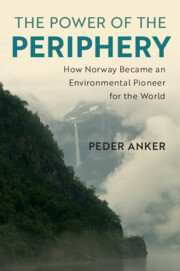The Power of the Periphery
What is the source of Norway’s culture of environmental harmony in our troubled world? Exploring the role of Norwegian scholar-activists of the late twentieth century, Peder Anker examines how they portrayed their country as a place of environmental stability in a world filled with tension. In contrast with societies dirtied by the hot and cold wars of the twentieth century, Norway’s power, they argued, lay in the pristine, ideal natural environment of the periphery. Globally, a beautiful Norway came to be contrasted with a polluted world and fashioned as an ecological microcosm for the creation of a better global macrocosm. In this innovative, interdisciplinary history, Anker explores the ways in which ecological concerns were imported via Rachel Carson’s Silent Spring in 1962, then to be exported from Norway back to the world at the Earth Summit in Rio de Janeiro in 1992. This title is also available as Open Access on Cambridge Core.
Peder Anker is Associate Professor at The Gallatin School of Individualized Study, New York University. He is also Professor II in History of Science at the University of Oslo. He is on Twitter @pederanker.

